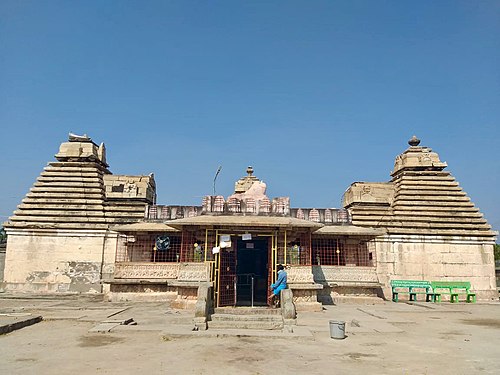The Chaya Someswara Temple, situated in Panagal, Telangana, is a historic temple dedicated to Lord Shiva, worshipped as Someswara. Positioned near the village’s ancient water tank, it’s renowned for a striking shadow effect, where a pillar’s shade forms a lingam-like shape, earning the name “Chaya” (shadow).
Historical Overview
The temple was constructed in the 11th century CE under the Kakatiya dynasty’s rule. Panagal, near Warangal, was a vital center for culture and faith. Stone carvings credit King Rudra Deva, a Kakatiya ruler, with building the temple, alongside other shrines like the nearby Pachala Someswara. The shadow effect, a marvel of design, showcases Kakatiya skill in blending art and astronomy. In the 14th century, Delhi Sultanate raids harmed Panagal, but villagers safeguarded the temple. The Someswara lingam was hidden in a well during attacks. In the 1960s, the Archaeological Survey of India restored the temple, keeping its Kakatiya splendor. Today, it stands as a symbol of devotion and craftsmanship, drawing worshippers and history buffs alike.
Mythological Importance
The temple honors Lord Shiva as Someswara, believed to bring peace and spiritual power. The black-stone lingam, central to worship, is paired with the shadow effect, seen as a divine mark. Smaller idols of Parvati, Ganesha, and Nandi surround the sanctum, representing unity and reverence. A local myth tells of a Kakatiya priest, Somayya, who prayed to Shiva to end a drought. Shiva appeared in a dream, promising rain if a temple was built. The shadow’s lingam shape was a sign of his presence, and the temple rose from this pledge.
Local Stories and Traditions
One treasured tale is about Narayana, a mason in the 1100s, who worked on the temple. Saved from a falling stone, he carved a stone Nandi, still in the courtyard. Another story speaks of Anantha, a widow in the 1700s, whose fevered son healed after she prayed here.
Another tale tells of Venkat, a farmer, who, during a lean year, prayed and vowed his first crop. Rain came, his fields flourished, and now farmers bring grains each year. Locals also share how a childless couple, after praying here, had a son and began tying green threads by Parvati’s shrine for others to have children. These stories, told by Panagal villagers, make the temple feel alive with history.
Locals of the village follow old traditions. Women offer sesame seeds at the shrine for kin’s health, while students tie cloth knots before tests, trusting Shiva hones their wits. At festivals, families share rice cakes with visitors, keeping a vow from a sickness’s end. These habits show the temple’s deep role in village life.
Temple Structure and Design
The temple uses a Kakatiya style, mixing Dravidian and Nagara traits. The gopuram, restored in 1965, has carvings of Shiva, Parvati, and celestial dancers. The sanctum holds the black-stone lingam, where the shadow effect appears on clear days. The vimana, a stepped roof over the sanctum, is etched with lotus patterns. Small shrines for Parvati, Ganesha, and Subrahmanya are inside. The temple sits by Panagal’s tank, with stone paths for rituals. The carved pillars, showing gods and myths, highlight Kakatiya artistry. The design focuses on worship, with the shadow play sparking wonder for its craft.
Rituals and Festivals
Maha Shivaratri in February or March is the largest, with all-night Rudrabhishekam and processions. Karthika Masam in October or November has lamp-lighting rituals. Ugadi, the Telugu New Year in March or April, brings floral offerings. Daily worship includes Suprabhata Seva (morning prayers), Archana (offerings), and Deeparadhana (lamp ritual). Services like Abhishekam and Rudra Homa can be booked at the temple office. A prasad stall gives free jaggery sweets to the devotees. A special ritual, Sankalpa Puja, lets devotees state their prayers before offerings, thought to draw Shiva’s grace. Bilva Archana, offering bilva leaves on Mondays, is for calm. These keep the temple’s fire burning.
Information for Travelers
Hours and Entry: Open daily, 6:00 AM to 12:00 PM, then 3:00 PM to 8:00 PM. Entry is free, but rituals cost extra.
Clothing: Wear modest clothes. Men doing rituals wear dhotis and go shirtless, as is custom.
How to Get There:
Air: Hyderabad’s Rajiv Gandhi Airport, 100 km away, is nearest. Buses or taxis go to Panagal.
Train: Nalgonda Railway Station, 15 km away, links to Hyderabad and major towns.
Road: Panagal is 100 km from Hyderabad, 3 km from Nalgonda. Buses run often from Hyderabad’s Dilsukhnagar.
Best Time to Visit: October to March has good weather. Weekdays are quiet. Krishna Pushkaralu, every 12 years, is a big event—next in 2028.
Historical and Cultural Details
Kakatiya kings built the temple with devotion and legacy, per 11th-century records. The shadow effect might tie to Kakatiya star knowledge, lining up with the sun. Locals keep old customs. Farmers give first grains to Shiva for rich crops, a village way. Women burn camphor at the shrine for grit, taught by elders.
Panchamruta Abhishekam, is a rare custom is offering five nectars on Shivaratri for blessings. Karthika Deepam, a lamp ritual in November, is one of the important festival celebrated in the temple.











